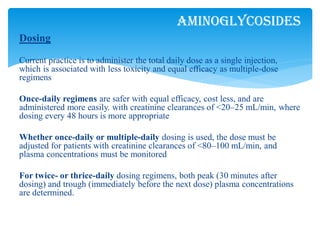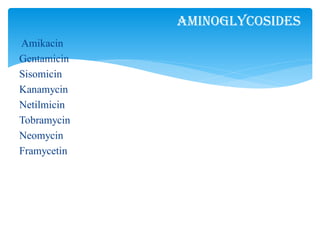Aminoglycosides p pt
- 1. Aminoglycosides PRESENTED BY: J.Manohar Reddy REG NO Y19MPH0252 DEPARTMENT OF PHARMCOLOGY HINDU COLLEGE OF PHARMACY
- 2. Aminoglycosides The first aminoglycoside, the antibiotic streptomycin, was discovered in 1944 by American biochemists Selman Waksman, Albert Schatz, and Elizabeth Bugie, who isolated the compound from Streptomyces griseus, a strain of soil bacteria . The aminoglycosides are first-line therapy for a limited number of very specific, often historically prominent infections, such as plague, tularemia, and tuberculosis; they also are frequently used to treat infections caused by aerobic gram-negative bacteria Aminoglycosides are used for the treatment of serious infections due to aerobic gram-negative bacilli
- 3. Classification Systemic aminoglycosides Streptomycin Amikacin Gentamicin Topical aminoglycosides Sisomicin Neomycin Kanamycin Framycetin Netilmicin Tobramycin Aminoglycosides
- 4. Mechanism Of Action The aminoglycoside antibiotics are rapidly bactericidal. Bacterial killing is concentration-dependent, but residual bactericidal activity persists even after the serum concentration has fallen below the minimum inhibitory concentration. These properties account for the efficacy of once-daily dosing regimens. Driven by the membrane electrical potential aminoglycosides diffuse through aqueous channels formed by porin proteins in the outer membrane of gram-negative bacteria and enter the periplasmic space Aminoglycosides
- 5. Mechanism Of Action This rate-limiting process can be blocked or inhibited by a reduction in pH or anaerobic conditions, as in an abscess. Once inside the cell, aminoglycosides bind to polysomes and interfere with protein synthesis by causing misreading and premature termination of mRNA translation The resulting aberrant proteins may be inserted into the cell membrane, altering permeability and further stimulating aminoglycoside transport. Aminoglycosides
- 6. Microbial Resistance To The Aminoglycosides Resistance to aminoglycosides occurs via: 1) efflux pumps, 2) decreased uptake, and/or 3) modification and inactivation by plasmid-associated synthesis of enzymes. Each of these enzymes has its own aminoglycoside specificity; therefore, cross-resistance cannot be presumed. [Note: Amikacin is less vulnerable to these enzymes than other antibiotics in this group.] Aminoglycosides
- 7. Antibacterial Spectrum Of The Aminoglycosides The antibacterial activity of most aminoglycosides is directed primarily against aerobic gram-negative bacilli including those that may be multidrug resistant, such as Pseudomonas aeruginosa, Klebsiella pneumoniae, and Enterobacter sp. Additionally, aminoglycosides are often combined with a β- lactam antibiotic to employ a synergistic effect, particularly in the treatment of Enterococcus faecalis and Enterococcus faecium infective endocarditis. Aminoglycosides
- 8. Absorption, Distribution, Dosing, And Elimination Of The Aminoglycosides Absorption The highly polar, polycationic structure of the aminoglycosides prevents adequate absorption after oral administration. The aminoglycosides are highly polar and, thus, poorly absorbed from the gastrointestinal (GI) tract. The aminoglycosides are highly polar and, thus, poorly absorbed from the gastrointestinal (GI) tract. Aminoglycosides are absorbed rapidly after intramuscular injection. Aminoglycosides
- 9. Distribution All the aminoglycosides have similar pharmacokinetic properties. These polar drugs do not penetrate into most cells, central nervous system (CNS), and the eye. Except for streptomycin, there is negligible binding of aminoglycosides to plasma proteins. The volume of distribution of these drugs approximates the volume of extracellular fluid. Concentrations of aminoglycosides in secretions and tissues are low [Note: Due to low distribution into fatty tissue, the aminoglycosides are dosed based on lean body mass, not actual body weight.] Aminoglycosides
- 10. Dosing Current practice is to administer the total daily dose as a single injection, which is associated with less toxicity and equal efficacy as multiple-dose regimens Once-daily regimens are safer with equal efficacy, cost less, and are administered more easily. with creatinine clearances of <20–25 mL/min, where dosing every 48 hours is more appropriate Whether once-daily or multiple-daily dosing is used, the dose must be adjusted for patients with creatinine clearances of <80–100 mL/min, and plasma concentrations must be monitored For twice- or thrice-daily dosing regimens, both peak (30 minutes after dosing) and trough (immediately before the next dose) plasma concentrations are determined. Aminoglycosides
- 11. Elimination More than 90% of the parenteral aminoglycosides are excreted unchanged in the urine The aminoglycosides are excreted almost entirely by glomerular filtration, and urine concentrations of 50–200 µg/mL are achieved. The plasma half-lives of the aminoglycosides vary between 2 and 3 hours in patients with normal renal function. Aminoglycosides
- 12. Adverse Effects Of The Aminoglycosides All aminoglycosides can produce reversible and irreversible vestibular, cochlear, and renal toxicity. Ototoxicity Ototoxicity (vestibular and auditory) is directly related to high peak plasma levels and the duration of treatment Nephrotoxicity Approximately 8–26% of patients who receive an aminoglycoside for more than several days will develop mild renal impairment that almost always is reversible It manifests as tubular damage resulting in loss of urinary concentrating power, low g.f.r., nitrogen retention, albuminuria and casts. Aminoglycosides
- 13. Neuromuscular paralysis This adverse effect is associated with a rapid increase in concentrations (for example, high doses infused over a short period.) or concurrent administration with neuromuscular blockers. Allergic reactions: Contact dermatitis is a common reaction to topically applied neomycin Aminoglycosides
- 14. Precautions And Interactions 1.Avoid aminoglycosides during pregnancy: risk of foetal ototoxicity. 2. Avoid concurrent use of other ototoxic drugs, e.g. high ceiling diuretics, minocycline. 3. Avoid concurrent use of other nephrotoxic drugs, e.g. amphotericin B, vancomycin, cyclosporine and cisplatin. 4. Cautious use in patients past middle age and in those with kidney damage. 5. Cautious use of muscle relaxants in patients receiving an aminoglycoside. 6. Do not mix aminog lycoside with any drug in the same syringe/infusion bottle. Aminoglycosides
- 15. Streptomycin Streptomycin is used for the treatment of certain unusual infections usually in combination with other antimicrobial agents Because it is less active than other members of the class against aerobic gram-negative rods, it has fallen into disuse. Pharmacokinetics Streptomycin is highly ionized. It is neither absorbed nor destroyed in the g.i.t. However, absorption from injection site in muscles is rapid. It is distributed only extracellularly: volume of distribution (0.3 L/kg) is nearly equal to the extracellular fluid volume Streptomycin is not metabolized-excreted unchanged in urine. Glomerular filtration is the main channel:. . Aminoglycosides
- 16. Adverse effects About 1/5 patients given streptomycin 1 g BD i.m. experience vestibular disturbances. Auditory disturbances are less common. Streptomycin has the lowest nephrotoxicity among aminoglycosides; probably because it is not concentrated in the renal cortex. Hypersensitivity reactions are rare; rashes, eosinophilia, fever and exfoliative dermatitis have been noted. .-naphylaxis is very rare. Uses Tuberculosis, Plague, Tularemia Aminoglycosides
- 17. Amikacin Gentamicin Sisomicin Kanamycin Netilmicin Tobramycin Neomycin Framycetin Aminoglycosides
- 18. THANK YOU
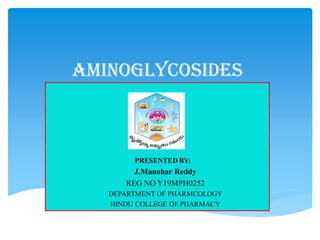
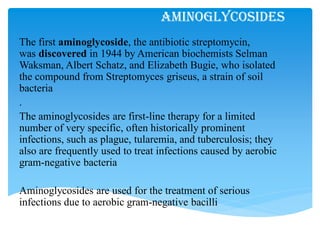
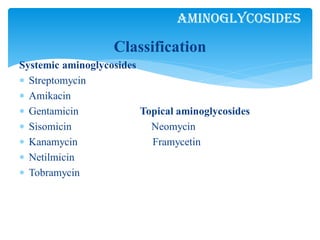
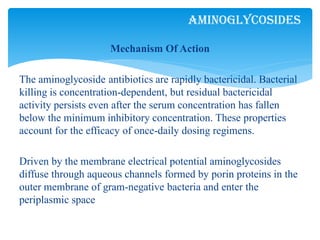

![Microbial Resistance To The Aminoglycosides
Resistance to aminoglycosides occurs via: 1) efflux pumps, 2)
decreased uptake, and/or 3) modification and inactivation by
plasmid-associated synthesis of enzymes.
Each of these enzymes has its own aminoglycoside specificity;
therefore, cross-resistance cannot be presumed.
[Note: Amikacin is less vulnerable to these enzymes than other
antibiotics in this group.]
Aminoglycosides](https://image.slidesharecdn.com/aminoglycosidesppt-210130121246/85/Aminoglycosides-p-pt-6-320.jpg)

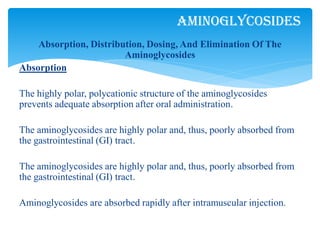
![Distribution
All the aminoglycosides have similar pharmacokinetic properties.
These polar drugs do not penetrate into most cells, central nervous
system (CNS), and the eye.
Except for streptomycin, there is negligible binding of
aminoglycosides to plasma proteins.
The volume of distribution of these drugs approximates the volume of
extracellular fluid.
Concentrations of aminoglycosides in secretions and tissues are low
[Note: Due to low distribution into fatty tissue, the aminoglycosides are
dosed based on lean body mass, not actual body weight.]
Aminoglycosides](https://image.slidesharecdn.com/aminoglycosidesppt-210130121246/85/Aminoglycosides-p-pt-9-320.jpg)
